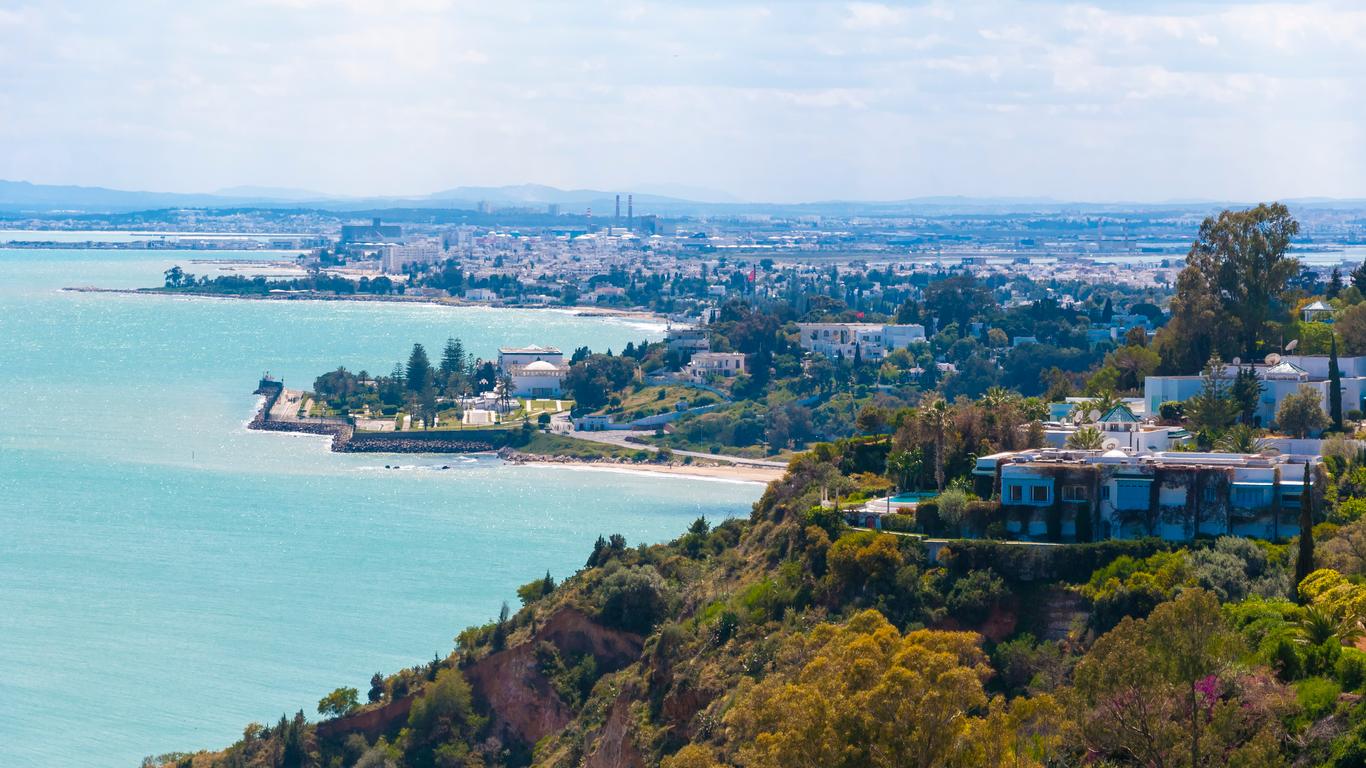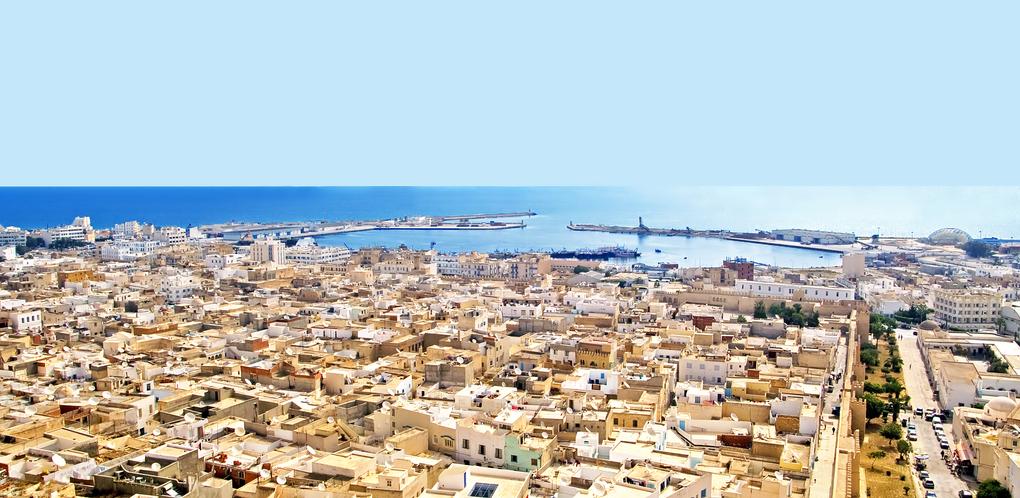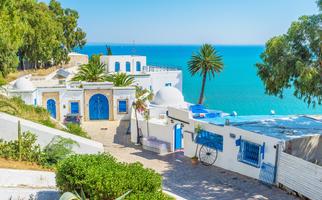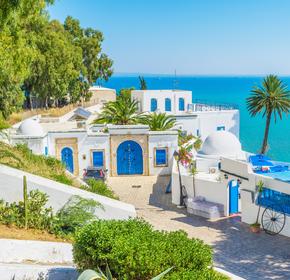
Tunis travel guide
Tunis Tourism | Tunis Guide
You're Going to Love Tunis
Tunis is the capital of Tunisia and is located on the southern shores of the Mediterranean Sea. It is a compact city, with a population of less than 700,000, and is easily explored on foot. The city has many ancient buildings and a captivating mix of North African and French architecture.

Top 5 Reasons to Visit Tunis
1. Carthage
The ancient city of Carthage is just outside of Tunis and has some of the most impressive Roman ruins outside of Rome itself.
2. Ancient Ruins
Tunis has lots of ancient sites and they can all be accessed using one very reasonable admission ticket, which costs TND10.
3. The Medina
The souq in the ancient medina of Tunis sells all manner of goods, from spices to fashion. It is probably one of the most relaxed in North Africa but is still an authentic, working market.
4. Belvedere Park
Belvedere Park is home to the National Center for Living Art, a zoo, and the Lake of Tunis, making for a relaxing escape from the city.
5. Zitouna Mosque
This is the largest mosque in Tunisia and dates from the 8th century. Tourists can view this important landmark from a platform for TND3.
What to do in Tunis
1. Medina: A UNESCO World Heritage Site
If you'd like to see the glory of one of the Medieval world's greatest civilizations, look no further than the Medina of Tunis. Here, over 700 monuments bear witness to a storied city whose wealth and power was known the world over. From mosques to palaces to fountains, the medina's winding streets will lead you past incredible wonders. Each step offers the chance to learn about the region's history; admire the intricacies of Islamic art and architecture, and get a feel for the way that medinas have been incorporated into modern cities all over the world.
2. National Museum of Bardo: The National Museum of Bardo: Travel Back in Time
The second-largest museum on the continent, this facility is a wonder in and of itself. The building offers unique examples of historic Islamic decorative arts. Meanwhile, the exhibits range from ancient Roman mosaics recovered from Carthage to Greek statues and the artifacts and tools of the region's Berbers. You can also learn about the accomplishments of the Islamic cultures that called the place home. In short, as you walk through the halls you'll pass through millennia in one of the world's most multicultural melting pots: the Mediterranean.
3. Byrsa: Be Blown Away by the View
Byrsa was a citadel upon a cliff overlooking Carthage. Today, it is one of the region's most compelling archaeological zones. The ruined walls of this once-mighty fortress stand above the city and offer spectacular vistas over the Mediterranean. Meanwhile, the recent past has brought a mighty Cathedral, as well as the Museum of Carthage, to this location. Today, Byrsa is as much a cultural center as it is a monument. It's an absolute must during your stay in Tunis.
4. Souk El Attarine: Shop with the Locals
Tunis' many souks are still active and cater to both locals and visitors. One of the most interesting ones is the Souk el Attarine. Wander through its halls and you'll pass crowded stands full of aromatic goods such as jasmine and rose water. This perfume and beauty goods souk has regional products that have been traded for centuries, such as amber, as well as more modern cosmetics for sale. Best of all, it is still used by many Tunisians, so it offers a look at the way that locals shop -- good luck getting the local prices, though! If you love haggling, this is certainly the place for you.
5. Sidi Bou Said: Because Vacations Are Also About Relaxing
Perhaps no Tunisian town is more picturesque, more quintessentially Mediterranean, than Sidi Bou Said. This famous village has been a getaway for artists and bohemians for centuries, and a place of pilgrimage for nearly a thousand years. The white and blue walls and decorative doors and stairways of the city make it difficult to imagine that one stands in the real world and not in a painting. It's the ultimate destination for those trying to escape the hustle and bustle of city life.


1. Medina: A UNESCO World Heritage Site
If you'd like to see the glory of one of the Medieval world's greatest civilizations, look no further than the Medina of Tunis. Here, over 700 monuments bear witness to a storied city whose wealth and power was known the world over. From mosques to palaces to fountains, the medina's winding streets will lead you past incredible wonders. Each step offers the chance to learn about the region's history; admire the intricacies of Islamic art and architecture, and get a feel for the way that medinas have been incorporated into modern cities all over the world.
2. National Museum of Bardo: The National Museum of Bardo: Travel Back in Time
The second-largest museum on the continent, this facility is a wonder in and of itself. The building offers unique examples of historic Islamic decorative arts. Meanwhile, the exhibits range from ancient Roman mosaics recovered from Carthage to Greek statues and the artifacts and tools of the region's Berbers. You can also learn about the accomplishments of the Islamic cultures that called the place home. In short, as you walk through the halls you'll pass through millennia in one of the world's most multicultural melting pots: the Mediterranean.
3. Byrsa: Be Blown Away by the View
Byrsa was a citadel upon a cliff overlooking Carthage. Today, it is one of the region's most compelling archaeological zones. The ruined walls of this once-mighty fortress stand above the city and offer spectacular vistas over the Mediterranean. Meanwhile, the recent past has brought a mighty Cathedral, as well as the Museum of Carthage, to this location. Today, Byrsa is as much a cultural center as it is a monument. It's an absolute must during your stay in Tunis.
4. Souk El Attarine: Shop with the Locals
Tunis' many souks are still active and cater to both locals and visitors. One of the most interesting ones is the Souk el Attarine. Wander through its halls and you'll pass crowded stands full of aromatic goods such as jasmine and rose water. This perfume and beauty goods souk has regional products that have been traded for centuries, such as amber, as well as more modern cosmetics for sale. Best of all, it is still used by many Tunisians, so it offers a look at the way that locals shop -- good luck getting the local prices, though! If you love haggling, this is certainly the place for you.
5. Sidi Bou Said: Because Vacations Are Also About Relaxing
Perhaps no Tunisian town is more picturesque, more quintessentially Mediterranean, than Sidi Bou Said. This famous village has been a getaway for artists and bohemians for centuries, and a place of pilgrimage for nearly a thousand years. The white and blue walls and decorative doors and stairways of the city make it difficult to imagine that one stands in the real world and not in a painting. It's the ultimate destination for those trying to escape the hustle and bustle of city life.


Where to Eat in Tunis
Atlas le Resto serves good local food, such as iftar and fish soup, from TND9.50. Dar el Jeld serves more upmarket Tunisian food in a beautiful covered courtyard, with mains from TND20.
When to visit Tunis
Tunis has a hot Mediterranean climate and summer temperatures can top 116 degrees Fahrenheit. Late fall through to early spring may be more comfortable for visitors.
How to Get to Tunis
Plane
Tunis-Carthage Airport (TUN) is only 5 miles from the city center and has good links with Europe. A taxi into the city center will cost around TND5. The number 35 bus will take you into town for just TND0.76 but takes around 30 minutes.
Train
Tunis Central Station on Place de Barcelone is at the center of Tunisia's rail network, with good connections to the country's other cities.
Car
Driving in Tunisia is not recommended for tourists. Roads are fairly poor, signage difficult, and local driving habits can be challenging.
Bus
Tunis is at the hub of more than 70 bus lines covering the country. The main stations are at Gare Bab el Fellah and Gare Bab Saadoun.
Airlines serving Tunis
Where to stay in Tunis
Medina - this is Tunis' old town and is home to the souq and ancient mosque. Its maze of narrow streets requires careful orienteering but has bags of character.
Popular Neighborhoods in Tunis
Ville Nouvelle - Ville Nouvelle is the French Colonial new town, with broad avenues and most of the better hotels.
Hammamet - this is a beach resort just outside of the city. It can be easily reached in around one hour in a shared taxi, at a cost of around TND5. Here you will find lots of resort hotels.
Where to stay in popular areas of Tunis
Most booked hotels in Tunis
How to Get Around Tunis
Public Transportation
Tunis has an extensive public transport network, including trams, subway, and TGM light rail system. Tickets start at TND0.41.
Taxi
Taxis have an initial meter cost of TND0.40 and then cost around TND3.7 per mile.
Car
Driving in Tunis can be daunting, due to confusing driving habits and intermittent road signage. Car rental costs from around TND385 per day, and you'll find outlets of Sixt and Avis in town.
The Cost of Living in Tunis
Shopping Streets
The souq in the medina is the most exciting place to shop for local goods, where you can buy anything from spice to electronics.
Groceries and Other
Tunis has a couple of French supermarkets in Carrefour and Monoprix. A quart of will cost around TND1.13 and a loaf of bread just TND0.32.

